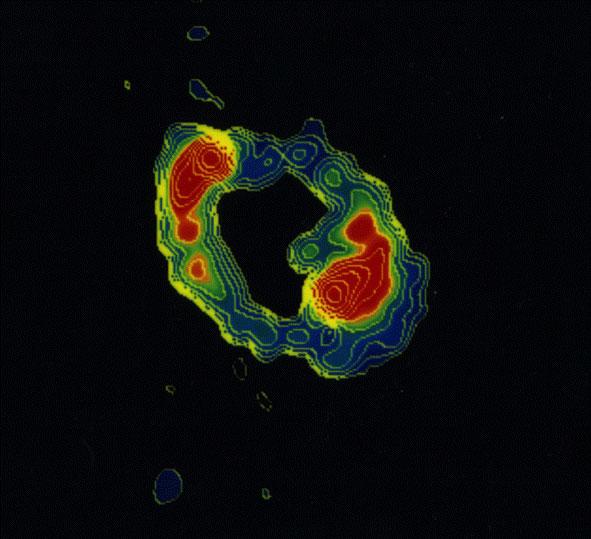
A radio image of a remote quasar that appears double because an intervening (unnamed) galaxy is distorting the shape with gravitational lensing. A team of SAO astronomers used the "extended SMA" to measure atomic carbon in this intervening galaxy.
Carbon is the fourth most abundant element in the universe, and an essential constituent of life. Atomic carbon is also a critical component in the giant gas clouds that populate galaxies and from which new stars and planets are made. The carbon both acts as a thermal coolant of the clouds, and as one of the primary ingredients for the numerous chemical reactions that produce complex molecules. Atomic carbon is fairly easy to study in our own and neighboring galaxies, but difficult to see in distant galaxies because its emission is so faint. Astronomers are nevertheless trying to measure it in remote galaxies because it plays such an essential role in the story of how galaxies develop in the early universe.
The quasar PKS1830-211 is an unusual object. It is a galaxy so far away that its light has been traveling for over 11.2 billion years, about 80% of the age of the universe. But what makes it dramatic is not its age but its shape: radio telescopes have found that it is a double object. Quasars are called by this term because they are thought to be "quasi-stellar" - that is, their light is dominated by a nucleus that appears point-like, like a star. A double quasar is therefore an oxymoron. The reason for this
double, however, is amazing: an unnamed galaxy lies between us and PKS1830-211 and acts as a gravitational lens, distorting the single image we would otherwise see into a double, just as a wineglass can distort the appearance of objects seen through it. Astronomers have spotted the very faint image of the intervening galaxy, and dated its light as having traveled for only 7.06 billion years; the galaxy is thus much closer to us than is the quasar. This much has been known for several years.
A team of five SAO astronomers, Meredith Hughes, Ken Young, Mark Gurwell, David Wilner, and Robert Christensen, together with eight colleagues, combined the Submillimeter Array (SMA) with two other telescopes for the first time to detect atomic carbon in the intervening galaxy. Called the eSMA (for "extended SMA"), the unique facility had the sensitivity to see atomic carbon, but not in its emitted light. Instead, the eSMA saw the gaseous carbon as it absorbed the intense light from the more distant quasar as that light passed through the lens galaxy. Analyses of the results suggest that the physical environments in the lens galaxy are unusual, with its gas clouds not nearly as mature as the ones in the Milky Way. The result not only addresses the development of such clouds in the early universe, it also highlights the power of the eSMA.